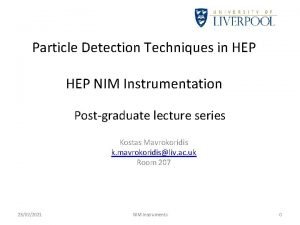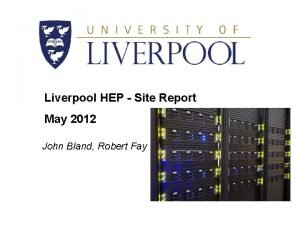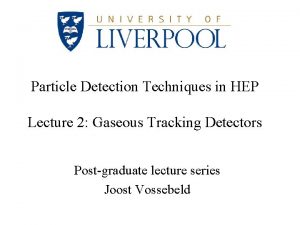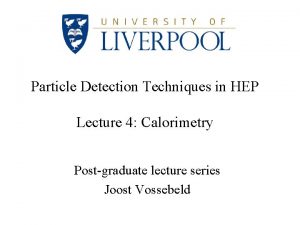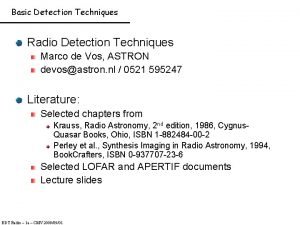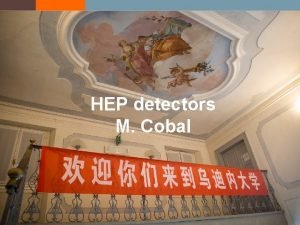Particle Detection Techniques in HEP NIM Instrumentation Postgraduate
















- Slides: 16

Particle Detection Techniques in HEP NIM Instrumentation Post-graduate lecture series Kostas Mavrokoridis k. mavrokoridis@liv. ac. uk Room 207 23/02/2021 NIM instruments 0

Recommended Text Books W. Leo, Techniques for Nuclear and Particle Physics experiments, Springer 1987 N. Tsouflanidis, Measurement and Detection of Radiation, Taylor and Francis 1995 23/02/2021 NIM instruments 1

Outline • The NIM standard • HV power supply • Preamplifiers • Amplifiers • Discriminators • Scaler • Oscilloscope • Digitisers • Coaxial cables • Cable termination and impedance matching 23/02/2021 NIM instruments 2

Basic pulse-type detector system 23/02/2021 NIM instruments 3

The NIM standard Most of the commercially available instruments that are used in high energy and nuclear physics conform to the standards of nuclear instrument modules (NIM). Any NIM module, for example a discriminator, power supply, amplifier etc. , will fit in any NIM crate. The standard NIM crate can accept 12 single width modules. The rear power connectors provide at least four standard dc voltages, +-12 V and +-24 V. 23/02/2021 NIM instruments 4

HV power supply The high-voltage power supply (HVPS) provides a positive or negative voltage necessary for the operation of the detector. Most detectors need positive high voltage (HV). As a safety mechanism when a high current (i. e. greater than 80% of the scale set on the unit) input occurs, which is most likely caused by a discharge in your detector, the power supply will trip and switch off 23/02/2021 NIM instruments 5

The Preamplifier The main purpose of the preamplifier is to provide an optimised coupling between the output of the detector and the rest of the counting system. The preamplifier is also necessary to minimize any sources of noise that may change the signal. The signal that comes out of the detector is very weak, in the m. V range. Thus, before it can be recorded, it will have to be amplified by a factor of a thousand or more. To achieve this, the signal will have to be transmitted through a cable to the next instrument of the counting system, which is the amplifier. Transmission of any signal through a cable attenuates it to a certain extent. If it is weak at the output of the detector, it might be lost in the electronic noise that accompanies the transmission. This is avoided by placing the preamplifier as close to the detector as possible. The preamplifier shapes the signal and reduces its attenuation by matching the impedance of the detector with that of the amplifier. After going through the preamplifier, the signal may be safely transmitted to the amplifier, which may be located at a considerable distance away. 23/02/2021 NIM instruments 6

The Amplifier The amplifier increases the signal by as many as 1000 times or more. Modern commercial amplifiers produce a maximum signal of 10 V, regardless of the input and the amplification. Equally importantly, the amplifier shapes the signal at the output of the preamplifier into a convenient form for further processing Coarse gain: This dial adjusts the amplification in steps. Each step is a fraction of the maximum amplification. Fine gain: This dial adjusts the amplification continuously within each step of the coarse gain. 23/02/2021 NIM instruments 7

The Discriminator The discriminator responds only to input signals with amplitudes higher than the set threshold in m. V. For signals that satisfy this condition a square pulse is generated. The threshold (typically 30 m. V to 500 m. V) and the width of the logic pulse can be adjusted by a screw on the front panel The most common use of the discriminator is to block low amplitude noise pulses from photomultipliers or other pulse-type detectors 23/02/2021 NIM instruments 8

The Scaler The scaler is a recorder of pulses. For every pulse entering the scaler, a count of 1 is added to the previous total. At the end of the counting period, the total number of pulses is displayed on the front panel. 23/02/2021 NIM instruments 9

The Oscilloscope The signals generated by a pulse type detector can be viewed by an oscilloscope. The horizontal axis of the screen measures time and the vertical axis gives volts. An important characteristic of the oscilloscope is its bandwidth which determines the response of the scope to very high frequency signals. Modern oscilloscopes provide an analogue as well as a digital signal with bandwidths between 200 MHz to 2 GHz 23/02/2021 NIM instruments 10

Analog to digital converters (ADC) An ADC device converts an analogue signal into a digital signal. The raw waveform data are then saved on a computer for further processing A modern high speed waveform digitiser from Agilent Important features of modern digitizers are: High bandwidth GHz range High-speed data acquisition at GS/s rates High dynamic range 23/02/2021 NIM instruments 11

Coaxial cables The coaxial cable consists of two concentric cylindrical conductors separated by a dielectric material. The advantage of this construction is that the outer cylindrical conductor (the screen) acts as the ground also shields the central wire from external electromagnetic fields of frequencies down to approximately 100 k. Hz. The characteristic impedance of a transmission cable is defined as: or for an ideal lossless coaxial cable it can be shown that Where a and b are the inner and outer diameters of the conductors and Km and Ke are the relative permeability and permittivity of the dielectric. The impedance of the coaxial cables ranges between 18 ohm and 200 ohm 23/02/2021 NIM instruments 12

Cable termination and Impedance Matching(a) The signal in a coaxial cable is the sum of the original and a reflected signal travelling in the opposite direction. Signal distortion from reflections can only be avoided by matching the device impedance to the cable impedance. 50 ohm termination NIM standard requires all input and output device impedances and cables to be 50 ohm. However, very often an impedance mismatch cannot be avoided. For example, oscilloscopes have a high impedance(~1 Mohm). Thus the cable has to be terminated with an additional impedance of an appropriate value in order to adjust the total load impedance seen by the cable. 23/02/2021 NIM instruments 13

Cable termination and Impedance Matching(b) Calculating the resistance value needed in order to avoid reflections between two cables of different impedances: For Z 1<Z 2 As the combination must equal Z 1 we have: 23/02/2021 For Z 1>Z 2 As we must increase the impedance seen by cable 1, we have to add a resistance R in series: NIM instruments 14

Next Lecture • Two phase ionisation/scintillation noble gas detectors • Putting together a liquid argon TPC from scratch • Visit to the Liverpool LAr lab 23/02/2021 NIM instruments 15
 Power supply for nim instrumentation
Power supply for nim instrumentation Difference between postgraduate and undergraduate
Difference between postgraduate and undergraduate Belarusian medical academy of postgraduate education
Belarusian medical academy of postgraduate education Kramer's postgraduate resocialization model stages
Kramer's postgraduate resocialization model stages Difference between postgraduate and undergraduate
Difference between postgraduate and undergraduate Latvia
Latvia Undergraduate graduate postgraduate
Undergraduate graduate postgraduate Susi grant income limits
Susi grant income limits Alexmed postgraduate
Alexmed postgraduate Ptal california letter
Ptal california letter Clinical governance postgraduate
Clinical governance postgraduate Hostile surveillance detection
Hostile surveillance detection Scoopyng
Scoopyng Surveillance detection route
Surveillance detection route Hep b vaccines
Hep b vaccines Hepatitis b vaccine schedule for adults
Hepatitis b vaccine schedule for adults Liverpool hep c
Liverpool hep c
